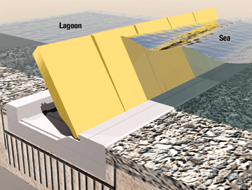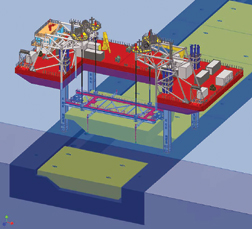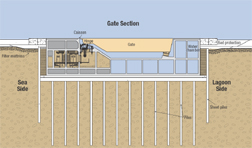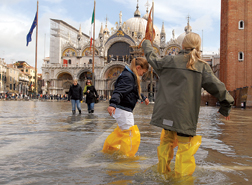...evolution. “I was convinced that once the final design started, all that would stop,” he says. “I was wrong.”
| + click to enlarge |
 Venice Water Authority/Consorzio Venezia Nuova |
| + click to enlarge |
 Venice Water Authority/Consorzio Venezia Nuova Flood gates are to rise from caissons placed in rock-armored mats on the sea floor.
|
The project’s main constraint was to leave the water exchange across the inlets unaffected, except when the barriers are shut, possibly for only about 25 hours a year. It took five years to secure official approval for the environmental impact study, in 2001, says Scotti. His team started definitive design work in 2003, with construction following a year later.
To ensure cost certainty, the government negotiated a fixed-price, lump-sum deal with CVN. Setting the price involved long negotiations based on costs of comparable work in the region, says Piva. The gates are the only major elements open to international bidding, probably next year.
With rising steel, fuel and other costs, the contract’s fixed price is creating tensions. Provisions allow compensation for unforeseeable price hikes, but none has yet been granted. “We are still working with the prices we presented in 2004,” says Brotto. Piva appears sympathetic, and is advising the government to be flexible to the situation.
With little influence to recover cost hikes from the owner, pressure to trim the project has been resisted. “I’m very happy with the design...I never reduced the quality,” says Scotti. “From time to time I was not very popular.”
Plugged
The design basically calls for 78 hinged-steel box gates spread across the roughly 400-m-wide inlets, at Chioggia, Malamocco and Lido. Lido’s inlet, the widest, is divided by an artificial island.
| + click to enlarge |
 Venice Water Authority/Consorzio Venezia Nuova |
Gates will normally be flooded to lie in seabed caissons. When tides rise 110 cm, compressed air will empty the gates of water, causing them to pivot upward. The system is planned for a 60-cm
sea-level rise, more than the worst forecast for the next century by the United Nation’s Intergovernmental Panel on Climate Change, claims the government.
Of some 30 possible gate types, only the hinged version satisfied all numerous constraints, such as being out of sight when not in use. “It was also the cheapest...and best for maintenance,” says Scotti.
The roughly 300-tonne gates will be 20 m wide, with lengths from 22 m to 30 m depending on water depth, and 4 m to 5 m thick. Set 8 cm apart, gates will each pivot on two 40-tonne hinges on the caissons.
Hinges will be spherical to ease installation tolerances, says Scotti. They will contain ducts for compressed air and instrumentation and their connectors must allow a gate to be replaced for maintenance, near the old Venice arsenal, in under eight hours.
With 160 hinges to be made, including spares, CVN is now focussing on production methods, says Scotti. A prototype is being made locally.
CVN will start casting caissons this year while gate design continues. The 10.5-m-deep caissons range in length from 40 m to 60 m and from 30 m to 45 m in width. Like sunken tube tunnels, they will be sealed together creating conduits for equipment and access.
 AP/Wideworld High tides and seas regularly flood historic Venice.
|
Caissons will rest in trenches dredged between steel pile walls and will generally be founded on piles. Soil at the shallow Lido inlet will be improved with jet grouting. Grouting is also reinforcing ground at the barriers’ abutments and ground around the caissons is being armored with rock on stone-filled mattresses, made on site and rolled out from a vessel by the Maccaferri Venice Project Consortium.
At Lido and Chioggia inlets, CVN will use the new small-craft refuge harbors as dry docks for caisson construction. “It is a very interesting solution for not using other construction sites in the lagoon...to reduce the impact,” say Brotto. With no such harbor at Malamocco, CVN is building a 16-hectare casting yard next to the almost-complete ship lock.
Caissons of up to 25,000 tonnes will be built on a platform supported by short columns. Space beneath will later accommodate numerous trolley-mounted jacks that will be synchronized to roll caissons to a ship lift at one edge, for lowering into the water.
Norwegian heavy-lift specialist TTS Marine A.S.A. will supply the transportation system. Rolls-Royce Naval Marine Ltd. is to deliver the lift late next year.

Post a comment to this article
Report Abusive Comment